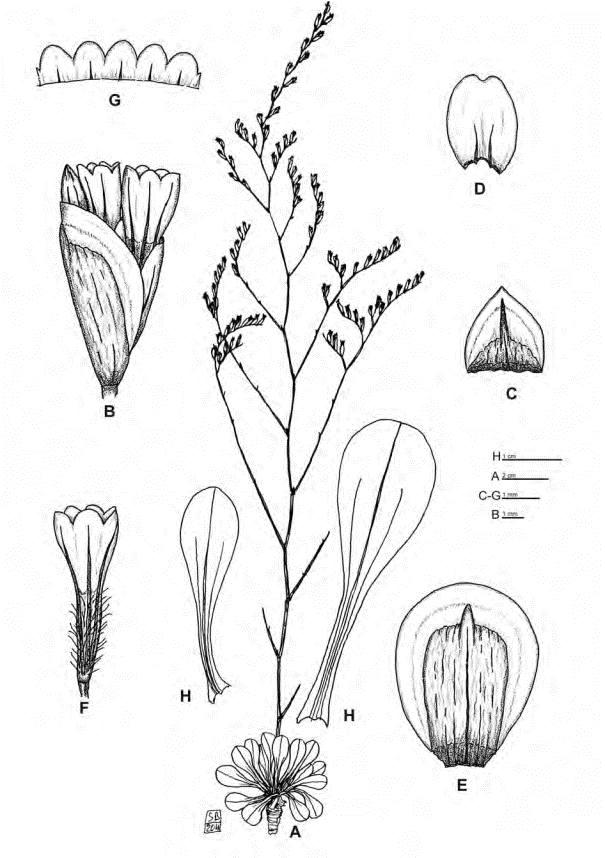LIMONIUM SIEBERI
1. Limonium sieberi (Boissier) Kuntze (1891: 396) (Fig. 40)
Basionym:-Statice sieberi Boissier (1841: 530). Type (lectotype designated by Bokhari & Edmondson, 1982):-GREECE. Crete: Crète, Rettimo ad Mare, s.d., Sieber s.n, sub Statice spathulata Desf. (K!, isolectotypes G!, G-DC!, K!, M!, OXF!, P!, PC!, W!).
= Limonium runemarkii Rechinger fil. (1961: 370). Type (lectotype, designated here):-GREECE. Euboea: Insula Euboea meridionalis, ad promontorium austr.-occidentalem insulae in saxosis litoreis insulae Mantili, 21 June 1958, Rechinger18855 (M!, isolectotypes B!, G!, W!).
Description:-Plant perennial, glabrous, forming a sub-shrub 20-50 cm tall, with few to several erect stems and a robust tap-root. Caudices 10-60 mm long, densely branched, densely spirally leafy in the upper half, living leaves in rosettes at apices. Leaves fleshy, rigid, rugose, green to slightly glaucous, flat, 20-60 mm long and 6-18 mm broad, spathulate to oblanceolate, apex obtuse to rounded, mucronate, 1 central nerve with 2 lateral nerves at least on large leaves, gradually tapering into the petiole. Stems 10-45 cm long, rugose or sometimes slightly verrucate, green to glaucous, slightly flexuous, branching begins above lower quarter of the stems. Inflorescence paniculate or obtrullate in outline. Sterile branches absent or only 1-5 per stem, 1-9 cm long, straight, unbranched. Fertile branches 3-13 cm long, straight to slightly curved, directed obliquely upwards, forming branching angles of 25°-50°, only longer branches divided. Spikes 10-80 mm long, straight to slightly curved, erect, inserted obliquely upwards or spreading. Spikelets 6.5-9.0 mm long, composed of 1-3 flowers, remotely arranged with 2-3 per cm. Outer bract 2.0-2.8 mm long and 2.0-2.6 mm broad, triangular-ovate, obtuse to acute; bract margin broadly membranous; central part slightly fleshy only at base, acuminate. Middle bract membranous, 2.2-3.2 mm long and 1.7-2.7 mm broad, oblong-elliptic to oblong-obovate, rounded. Inner bract 5.2-7.0 mm long and 3.4-4.3 mm broad, elliptic to obovate, rounded; bract margin broadly membranous; central part fleshy, 4.1-5.8 mm long and 2.2-3.4 mm broad, oblong, acuminate, forming a narrowly triangular tip, 0.7-1.0 mm long, not reaching the upper margin. Calyx 5.2-6.8 mm long, exceeding the inner bract by 1.5-2.5 mm; calyx tube glabrous or sparsely to densely shortly to long hairy, with 5 ribs ending before or at the base of lobes; calyx lobes ca. 0.6 × 1.0 mm, semi- elliptic to semi-circular; sometimes margin of calyx lacerate after anthesis. Corolla lilac to pale violet.
Chromosome number:-2n = 43 (Artelari & Georgiou 2003; Erben Li-1201, Li-1706, Li-1707, unpubl.).
Distribution:-L. sieberi is distributed in northern Crete, on the southeastern Peloponnese (Lakonia) and on the Aegean Islands of Kythira, Euboea and Alonissos (Fig. 94D).
Habitat:-Calcareous rocky coast.
Taxonomic remarks:-L. sieberi is similar in habit to L. pigadense, but it differs from the latter by having shorter caudices, 3-nerved leaves and narrower inner bracts. Plants with larger spikelets occur on the Peloponnese, around Gythio. L. sieberi also includes those populations previously ascribed to L. runemarkii Rechinger fil.
Basionym:-Statice sieberi Boissier (1841: 530). Type (lectotype designated by Bokhari & Edmondson, 1982):-GREECE. Crete: Crète, Rettimo ad Mare, s.d., Sieber s.n, sub Statice spathulata Desf. (K!, isolectotypes G!, G-DC!, K!, M!, OXF!, P!, PC!, W!).
= Limonium runemarkii Rechinger fil. (1961: 370). Type (lectotype, designated here):-GREECE. Euboea: Insula Euboea meridionalis, ad promontorium austr.-occidentalem insulae in saxosis litoreis insulae Mantili, 21 June 1958, Rechinger18855 (M!, isolectotypes B!, G!, W!).
Description:-Plant perennial, glabrous, forming a sub-shrub 20-50 cm tall, with few to several erect stems and a robust tap-root. Caudices 10-60 mm long, densely branched, densely spirally leafy in the upper half, living leaves in rosettes at apices. Leaves fleshy, rigid, rugose, green to slightly glaucous, flat, 20-60 mm long and 6-18 mm broad, spathulate to oblanceolate, apex obtuse to rounded, mucronate, 1 central nerve with 2 lateral nerves at least on large leaves, gradually tapering into the petiole. Stems 10-45 cm long, rugose or sometimes slightly verrucate, green to glaucous, slightly flexuous, branching begins above lower quarter of the stems. Inflorescence paniculate or obtrullate in outline. Sterile branches absent or only 1-5 per stem, 1-9 cm long, straight, unbranched. Fertile branches 3-13 cm long, straight to slightly curved, directed obliquely upwards, forming branching angles of 25°-50°, only longer branches divided. Spikes 10-80 mm long, straight to slightly curved, erect, inserted obliquely upwards or spreading. Spikelets 6.5-9.0 mm long, composed of 1-3 flowers, remotely arranged with 2-3 per cm. Outer bract 2.0-2.8 mm long and 2.0-2.6 mm broad, triangular-ovate, obtuse to acute; bract margin broadly membranous; central part slightly fleshy only at base, acuminate. Middle bract membranous, 2.2-3.2 mm long and 1.7-2.7 mm broad, oblong-elliptic to oblong-obovate, rounded. Inner bract 5.2-7.0 mm long and 3.4-4.3 mm broad, elliptic to obovate, rounded; bract margin broadly membranous; central part fleshy, 4.1-5.8 mm long and 2.2-3.4 mm broad, oblong, acuminate, forming a narrowly triangular tip, 0.7-1.0 mm long, not reaching the upper margin. Calyx 5.2-6.8 mm long, exceeding the inner bract by 1.5-2.5 mm; calyx tube glabrous or sparsely to densely shortly to long hairy, with 5 ribs ending before or at the base of lobes; calyx lobes ca. 0.6 × 1.0 mm, semi- elliptic to semi-circular; sometimes margin of calyx lacerate after anthesis. Corolla lilac to pale violet.
Chromosome number:-2n = 43 (Artelari & Georgiou 2003; Erben Li-1201, Li-1706, Li-1707, unpubl.).
Distribution:-L. sieberi is distributed in northern Crete, on the southeastern Peloponnese (Lakonia) and on the Aegean Islands of Kythira, Euboea and Alonissos (Fig. 94D).
Habitat:-Calcareous rocky coast.
Taxonomic remarks:-L. sieberi is similar in habit to L. pigadense, but it differs from the latter by having shorter caudices, 3-nerved leaves and narrower inner bracts. Plants with larger spikelets occur on the Peloponnese, around Gythio. L. sieberi also includes those populations previously ascribed to L. runemarkii Rechinger fil.

FIGURE 40. Limonium sieberi (Boissier) Kuntze. A) Habit; B) Spikelet; C) Outer bract; D) Middle bract; E) Inner bract; F) Calyx; G) Calyx lobes; H) Leaves. (Habit and leaves drawn from “Creta, Rethimno, Brullo & Pavone s.n., CAT”, spikelet details from “Crète, Rettimo ad Mare, Sieber s.n, M”).